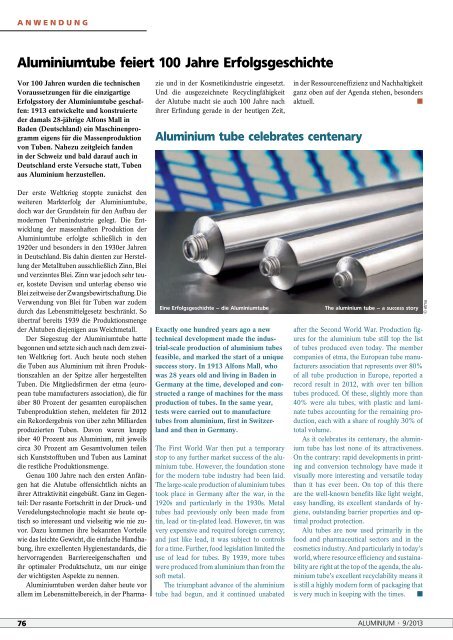sPeCIAL ArABAL - ALUMINIUM-Nachrichten – ALU-WEB.DE
sPeCIAL ArABAL - ALUMINIUM-Nachrichten – ALU-WEB.DE
sPeCIAL ArABAL - ALUMINIUM-Nachrichten – ALU-WEB.DE
Create successful ePaper yourself
Turn your PDF publications into a flip-book with our unique Google optimized e-Paper software.
ANWE NDUNG<br />
Aluminiumtube feiert 100 Jahre Erfolgsgeschichte<br />
Vor 100 Jahren wurden die technischen<br />
Voraussetzungen für die einzigartige<br />
Erfolgsstory der Aluminiumtube geschaffen:<br />
1913 entwickelte und konstruierte<br />
der damals 28-jährige Alfons Mall in<br />
Baden (Deutschland) ein Maschinenprogramm<br />
eigens für die Massenproduktion<br />
von Tuben. Nahezu zeitgleich fanden<br />
in der Schweiz und bald darauf auch in<br />
Deutschland erste Versuche statt, Tuben<br />
aus Aluminium herzustellen.<br />
Der erste Weltkrieg stoppte zunächst den<br />
weiteren Markterfolg der Aluminiumtube,<br />
doch war der Grundstein für den Aufbau der<br />
modernen Tubenindustrie gelegt. Die Entwicklung<br />
der massenhaften Produktion der<br />
Aluminiumtube erfolgte schließlich in den<br />
1920er und besonders in den 1930er Jahren<br />
in Deutschland. Bis dahin dienten zur Herstellung<br />
der Metalltuben ausschließlich Zinn, Blei<br />
und verzinntes Blei. Zinn war jedoch sehr teuer,<br />
kostete Devisen und unterlag ebenso wie<br />
Blei zeitweise der Zwangsbewirtschaftung. Die<br />
Verwendung von Blei für Tuben war zudem<br />
durch das Lebensmittelgesetz beschränkt. So<br />
übertraf bereits 1939 die Produktionsmenge<br />
der Alutuben diejenigen aus Weichmetall.<br />
Der Siegeszug der Aluminiumtube hatte<br />
begonnen und setzte sich auch nach dem zweiten<br />
Weltkrieg fort. Auch heute noch stehen<br />
die Tuben aus Aluminium mit ihren Produktionszahlen<br />
an der Spitze aller hergestellten<br />
Tuben. Die Mitgliedsfirmen der etma (european<br />
tube manufacturers association), die für<br />
über 80 Prozent der gesamten europäischen<br />
Tubenproduktion stehen, meldeten für 2012<br />
ein Rekordergebnis von über zehn Milliarden<br />
produzierten Tuben. Davon waren knapp<br />
über 40 Prozent aus Aluminium, mit jeweils<br />
circa 30 Prozent am Gesamtvolumen teilen<br />
sich Kunststofftuben und Tuben aus Laminat<br />
die restliche Produktionsmenge.<br />
Genau 100 Jahre nach den ersten Anfängen<br />
hat die Alutube offensichtlich nichts an<br />
ihrer Attraktivität eingebüßt. Ganz im Gegenteil:<br />
Der rasante Fortschritt in der Druck- und<br />
Veredelungstechnologie macht sie heute optisch<br />
so interessant und vielseitig wie nie zuvor.<br />
Dazu kommen ihre bekannten Vorteile<br />
wie das leichte Gewicht, die einfache Handhabung,<br />
ihre exzellenten Hygienestandards, die<br />
hervorragenden Barriereeigenschaften und<br />
ihr optimaler Produktschutz, um nur einige<br />
der wichtigsten Aspekte zu nennen.<br />
Aluminiumtuben werden daher heute vor<br />
allem im Lebensmittelbereich, in der Pharmazie<br />
und in der Kosmetikindustrie eingesetzt.<br />
Und die ausgezeichnete Recyclingfähigkeit<br />
der Alutube macht sie auch 100 Jahre nach<br />
ihrer Erfindung gerade in der heutigen Zeit,<br />
in der Ressourceneffizienz und Nachhaltigkeit<br />
ganz oben auf der Agenda stehen, besonders<br />
aktuell.<br />
■<br />
Aluminium tube celebrates centenary<br />
Eine Erfolgsgeschichte <strong>–</strong> die Aluminiumtube<br />
Exactly one hundred years ago a new<br />
technical development made the industrial-scale<br />
production of aluminium tubes<br />
feasible, and marked the start of a unique<br />
success story. In 1913 Alfons Mall, who<br />
was 28 years old and living in Baden in<br />
Germany at the time, developed and constructed<br />
a range of machines for the mass<br />
production of tubes. In the same year,<br />
tests were carried out to manufacture<br />
tubes from aluminium, first in Switzerland<br />
and then in Germany.<br />
The First World War then put a temporary<br />
stop to any further market success of the aluminium<br />
tube. However, the foundation stone<br />
for the modern tube industry had been laid.<br />
The large-scale production of aluminium tubes<br />
took place in Germany after the war, in the<br />
1920s and particularly in the 1930s. Metal<br />
tubes had previously only been made from<br />
tin, lead or tin-plated lead. However, tin was<br />
very expensive and required foreign currency;<br />
and just like lead, it was subject to controls<br />
for a time. Further, food legislation limited the<br />
use of lead for tubes. By 1939, more tubes<br />
were produced from aluminium than from the<br />
soft metal.<br />
The triumphant advance of the aluminium<br />
tube had begun, and it continued unabated<br />
The aluminium tube <strong>–</strong> a success story<br />
after the Second World War. Production figures<br />
for the aluminium tube still top the list<br />
of tubes produced even today. The member<br />
companies of etma, the European tube manufacturers<br />
association that represents over 80%<br />
of all tube production in Europe, reported a<br />
record result in 2012, with over ten billion<br />
tubes produced. Of these, slightly more than<br />
40% were alu tubes, with plastic and laminate<br />
tubes accounting for the remaining production,<br />
each with a share of roughly 30% of<br />
total volume.<br />
As it celebrates its centenary, the aluminium<br />
tube has lost none of its attractiveness.<br />
On the contrary: rapid developments in printing<br />
and conversion technology have made it<br />
visually more interesting and versatile today<br />
than it has ever been. On top of this there<br />
are the well-known benefits like light weight,<br />
easy handling, its excellent standards of hygiene,<br />
outstanding barrier properties and optimal<br />
product protection.<br />
Alu tubes are now used primarily in the<br />
food and pharmaceutical sectors and in the<br />
cosmetics industry. And particularly in today’s<br />
world, where resource efficiency and sustainability<br />
are right at the top of the agenda, the aluminium<br />
tube’s excellent recyclability means it<br />
is still a highly modern form of packaging that<br />
is very much in keeping with the times. ■<br />
© etma<br />
76 <strong><strong>ALU</strong>MINIUM</strong> · 9/2013
















